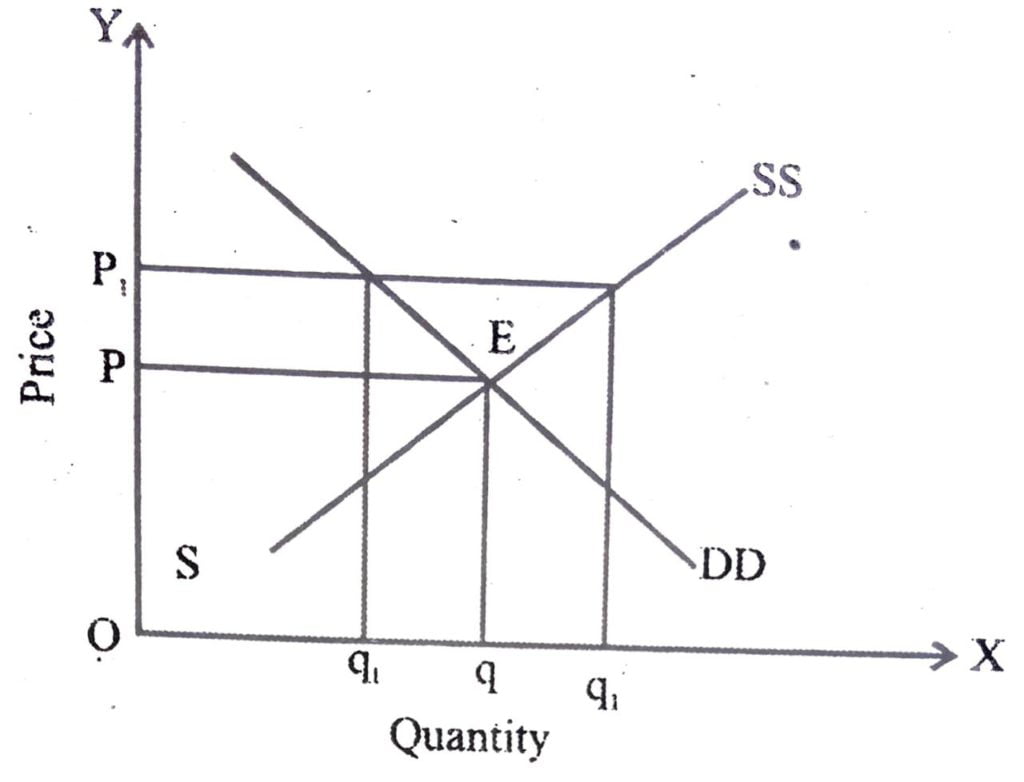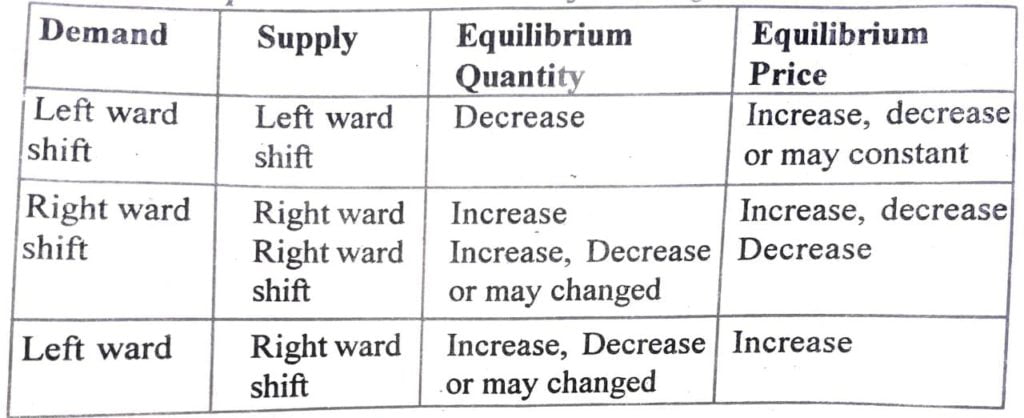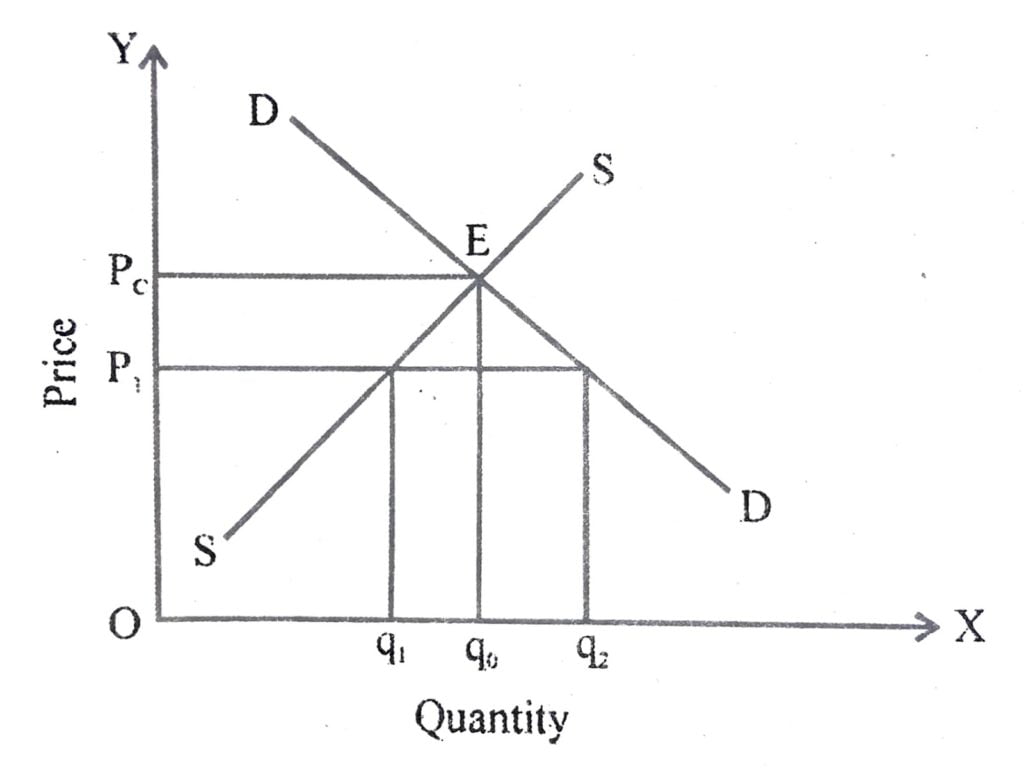Class 11 Economics Chapter 5 Market Equilibrium, (Assam Higher Secondary Education Council) AHSEC Class 11 Economics Question Answer in English Medium each chapter is provided in the list of AHSEC so that you can easily browse through different chapters and select needs one. Assam Board Chapter 5 Market Equilibrium Class 11 Economics Question Answer can be of great value to excel in the examination.
AHSEC Class 11 Economics Chapter 5 Market Equilibrium
Class 11 Economics Chapter 5 Market Equilibrium Notes cover all the exercise questions in SCERT Textbooks. The SCERT Class 11 Economics Chapter 5 Market Equilibrium Solutions provided here ensure a smooth and easy understanding of all the concepts. Understand the concepts behind every chapter and score well in the board exams.
Market Equilibrium
Chapter – 5
PART – A
VERY SHORT ANSWER QUESTIONS
1. What is an equilibrium ?
Ans: An equilibrium is defined as a situation, where the plans of all consumers and firms in the market match and the market clears.
2. What is an excess supply ?
Ans: If at a price, market supply is greater than market demand ,then there is an excess supply.
3. Name the situation in a perfectly competitive market in where a zero excess demand zero excess supply prevails.
Ans: The equilibrium situation.
4. Write true or false : When the wage rate increases, the opportunity cost of leisure decreases.
Ans: False
5. What is price floor ?
Ans: The government imposed lower limit on the price that may be charged for a particular good or services is called price floor.
6. Fill in the blanks :
With an increase in the wage rate the leisure becomes ―(costlier/cheaper).
Ans: costlier
7. What is price elasticity ?
Ans: Price elasticity of supply is the measure of change in supply of a commodity due to change in its price. According to Samuelson, “Elasticity of supply is the degree of responsiveness of supply of a commodity to a change in its price.” And according to Prof. Bilas, “Elasticity of supply is defined as the percentage change in quantity supplied, divided by percentage change in price.” The price elasticity of supply, denoted by e, is defined as follows
Price elasticity of supply(es)= Percentage change in quantity supplied/Percentage change in price.
8. Why ration-coupons are issued to the consumers by the government ?
Ans: To buy goods at cheaper price.
9. Choose the correct one:
The upper limit of the price of certain commodity imposed by the government is known as- (price-ceiling/price-floor)
Ans: Price ceiling.
10. Why does the government impose price-ceiling ?
Ans: See Q. No. 4, (Short Type I).
11. What is marginal revenue product of labour ?
Ans : MRPL = MR × MPL
=Marginal Revenue×Marginal Productivity of Labour
12. State true of false :
The equilibrium on firm earns normal profit.
Ans: False.
13. State true or false :
The equilibrium price is equal to the minimum average cost of the firm.
Ans: True.
14. Choose the correct one:
Imposition of price ceiling below the equilibrium price leads to an__ (excess demand/excess supply)
Ans: Excess demand.
15. State true or false :
Price-floor above the equilibrium price is imposed by the market.
Ans: False.
16. What is an excess demand ?
Ans: When the demands of the consumers exceeds the limited amount of supply of a commodity is called excess demand.
17. Choose the correct one:
Price ceiling is generally imposed on___(necessary items/luxury items)
Ans: luxury
18. State true or false:
Agricultural price support programme is an example of price floor.
Ans: True
19. Fill in the blanks:
Equilibrium price will be equal to the minimum___ of the firms.
Ans: MR (Marginal Revenue)
SHORT ANSWER QUESTION TYPE – II: (MARKS : 3)
1. Mention the assumption of market equilibrium.
Ans: (a) Price of the goods are fixed.
(b) Incomes remains constant.
(c) Technology does not change.
2. Distinguish between price-ceiling and price floor.
Ans: The government imposed upper limit on the price of a good or service is called price ceiling. Price ceiling is generally imposed on necessary items like wheat, rice, sugar and kerosene.
The government imposed lower limit on the price that may be charged for a particular good or services is called price floor.
3. Elaborate the structure conditions of a perfectly competitive market.
Ans: The following are the features of perfect competition :
(a) Large number of buyers and sellers : The number of buyers is very large. Accordingly, like an individual firm, an individual buyer is not able to influence price of the commodity. An increase or decrease in individual demand will hardly make any difference to the total market demand. Not only the number of buyers very large, also the number of firms selling a particular commodity is so large that any increase or decrease in the supply of one particular firm hardly influences the total market supply.
(b) Homogeneous product : All sellers sell identical units of a given product at a given price. Selling homogeneous product at the given price rules out the possibility of advertisement or other sale promotion expenses so that there are no selling costs in perfectly competitive market.
(c) Free entry and exit of firms : A firm can enter and leave any industry. There is no legal restriction on the entry or exit. .
(d) Perfect knowledge : Buyers and sellers are fully aware of the price prevailing in the market. Buyers know it fully well at what price sellers are selling a given product. As a consequence, only one price prevails in the market.
(e) Perfect mobility : Factors of production are perfectly mobile under perfect competition. Factors will move to that industry, which pays the highest remunerations.
(f) absence of transport cost : For one price to prevail throughout the market, it is essential that there is no extra transport cost for the consumers while buying a commodity from different sellers.
4. Show effect of price floor on market equilibrium.
Ans:

For certain goods and services, fall in price below a particular level is not desirable and hence, the government sets floors or minimum prices for these goods and services. The government imposed lower limit on the price that may be changed for a particular good or service is called price floor. Most well-known examples of imposition of price floor are agricultural price support programs and the minimum wage legislation.
Through an agricultural price support program, the government imposes a lower limit on the purchase price for some of the agricultural goods and the floor is normally set at a level higher than the market determined price for these goods. Similarly, through the minimum wage legislation, the government ensures that the wage rate of the labourers does not fall below a particular level and here again the minimum wage rate is set above the equilibrium wage rate. The figure shows the market supply and the market demand curve for a commodity on which price floor is imposed. The market equilibrium here would occur at price P and quantity q. But when the government imposes a floor higher than the equilibrium price at P₁, the market demand is q₁ whereas firms want to supply q’₁, thereby leading to an excess supply in the market equal to q’₁q₁.
In the case of agricultural support, to prevent price from falling because of excess supply, government needs to buy the surplus at the predetermined price.
5. Explain the concept of market equilibrium.
Ans: See Q. No. 1, (Long Type I).
6. Explain zero excess demand zero excess supply situation in a perfectly competitive market.
Ans: Zero excess demand zero excess supply situation in a perfectly competition market is a point where quantity demanded and quantity supplied are equal.
If the price of a commodity falls demand of that commodity will increase i.e. new consumers will emerge. These consumers possibly could not be offered this commodity due to less supply. Excess demand or shortage of goods shall push the price upward. As price rises, other things remain unchanged quantity demanded falls and quantity supplied increase. This process will continue until they become equal.
If price rise the demand will fall and supply will increase as the sellers may be tempted to produce and sell more at higher price. The excess supply over demand shall force the sellers to reduce the prices in order to dispose off their surplus stocks. All other thing remains unchanged as price falls quantity demanded rises and quantity supplied falls. This process stops when they become equal.
7. Mention some factors which affects the equilibrium price and quantity.
Ans: (i) Change in price of a related goods.
(ii) Change in number of consumers of a commodity.
(iii) Change in input price.
SHORT ANSWER QUESTIONS TYPE-I: (MARKS : 4)
1. Explain how to derive a market supply curve of labour.
Ans: The supply and demand curve in the labour market differ from those in the good market with respect to the source of supply and demand In the labour market, households are the suppliers of labour and the demani comes from firms, whereas in the good market, it is the opposite.
In the a perfectly competitive market, a profit maximising firm will always employ labour upto the point, where the extra cost she incurs for employing the last unit of labour is equal to the additional benefit she earns from that unit. The extra cost of hiring one more units of the labour is the wage rate (w), The extra output produced by one more unit of labour is its marginal product (MP₂) and by selling each extra unit of output the additional earning of the firm is the marginal revenue (MR) she gets from that unit. Thus the optional amount of labour is determined at that point where w = MPP₂ and MRP = MR × MP
2. Using a table show the impact of simultaneous shifts of demand and supply on equilibrium quantity and price of firm under perfect competition.
Ans: The impacts are shown on the following table :

3. Explain why with free entry and exit, each firm earns normal profit only at the prevailing market price.
Ans: Suppose the price at which equilibrium is attained is greater than the minimum of average cost. This will attract some new firms into the market. Consequently, the market supply of the product will increase leading to fall in its market price. The entry of new firms into the market will continue until abnormal profits are wiped out. In this way, in the long run, price will be equal to the minimum average cost.
4. What is rationing in the content of price-ceiling? State two adverse results of rationing.
Ans:

The government fixes a maximum price for a good or service. It is through that if essential goods like sugar, rice, wheat etc. were left to free market, poor people would not, able to buy them at the market determined price. Equilibrium price is presumed to be high. In such a situation, the government fixes maximum allowable price for contain goods which is called price ceiling.
The effect of price ceiling on market equilibrium is discuss through the example of market of rice. The figure given beside shows the market curve DD for rice and SS supply curve. The equilibrium price and quantity of rice are P, and respectively. When the government fixes the maximum price of rice at P, which is below the equilibrium price P, the producers will produce and supply less quantity q, of the commodity. Consumers on the other hand, demand more of the commodity i.e. q. Thus, quantity demanded exceeds the quantity supplied by q,q, amount. This means that everybody’s demand at this maximum price is not met or satisfied. Some consumers gain. Consumers who can purchase the commodity at the lower price are better off. But those consumers who can not purchase the commodity at all are worse off. The consumers who purchase the commodity may also face the quality deterioration. As the producers already have more buyers than can be actually served sellers may resort to a lower quality of a commodity. They don’t need to offer a higher quality rice to attract buyers.
In general, price ceiling accompanied by rationing of the goods may have the following advance consequences on the consumers; (a) Each consumer has to stand in long queues to buy the good from ration shops. (b) Since all consumers will not be satisfied by the quantity of the goods that they get from the fair price shop, some of then will be willing to pay higher price for it. This may result in the creation of black market.
5. Do you support price ceiling and rationing ? Why ? Justify your answer.
Ans: Same as above Q. No. 4
6. The demand and supply curve of a firm under perfectly competitive market are given below :
D=50-P
S = 25+ 3P,
Where,
P= Price level
D = Quantity demanded
S = Quantity supplied
– Find out the equilibrium level of price (P).
Ans: Given,
D=50-2P
S=25+3P
We know that, at equilibrium,
D=S
⇒ 50-2P = -25+3P
⇒ 5P=75
∴P=15, ie, equilibrium price.
Again, eqlbⁿ Quantity——–
D=50-2P
=50-2.15-50-30=20, i.e., equilibrium quantity.
7. The demand (D) and supply curve (S) of a firm is given below,
D=100–p
S=–25 +4p
Where
D= Quantity demanded
S= Quantity supplied
P= Price level.
Find out the equilibrium level of price (P).
Ans: Given, D=100–P and S= –25+4P.
In equilibrium, we know that
Demand= Supply
i.e. 100–P=–25+4P
⇒100+25=4P+P
⇒125=5P
⇒125/5=P
⇒>25=P
∴ Equilibrium Price = P = 25
8.Explain out Equilibrium behaviour in market equilibrium.
Ans:

Equilibrium means a state of balance, market equilibrium refers to a situation in which demand and supply are equal to a price.
In the diagram DD is the market demand curve and SS represents the market supply curve. The point of their intersection gives us equilibrium quantity price and quantity. Thus OP is the equilibrium price and OQs is the equilibrium quantity. At equilibrium price market demand equals market supply. E is the equilibrium points. At this point supply and demand act together to bring about market equilibrium.

Hi, I’m Dev Kirtonia, Founder & CEO of Dev Library. A website that provides all SCERT, NCERT 3 to 12, and BA, B.com, B.Sc, and Computer Science with Post Graduate Notes & Suggestions, Novel, eBooks, Biography, Quotes, Study Materials, and more.



